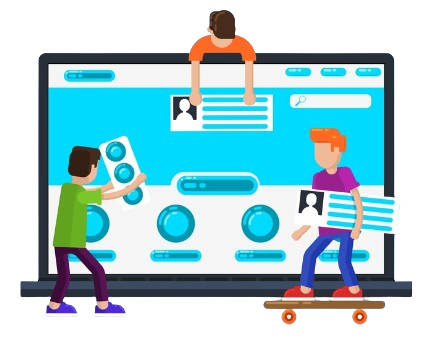Interactive Web Design is more than just a trend; it’s a powerful tool for creating engaging, user-friendly websites that stand out in today’s crowded digital landscape. By incorporating elements like animations, interactive forms, and personalization, you can create a website that not only captures attention but also drives meaningful user interactions.
In today’s digital age, where attention spans are fleeting and competition for user engagement is fierce, creating a website that captivates and holds your audience’s interest is no small feat. Enter Interactive Web Design—a dynamic approach to website creation that is transforming how users experience the web.
Gone are the days of static pages filled with walls of text. Now, users expect more. They crave an interactive, engaging, and personalized experience that draws them in and encourages them to explore further. But what exactly is Interactive Web Design, and how can it be leveraged to create more engaging websites?
What is Interactive Web Design?
Interactive Web Design involves creating websites that respond to user actions, providing real-time feedback, and enhancing the overall user experience. This could be as simple as a button changing color when hovered over. It can also be as complex as a multi-step form that adjusts questions based on previous answers. The goal is to create an interactive experience for the user. This approach makes them feel like an active participant, not just a passive observer.

The Importance of User Engagement
In the world of web design, user engagement is king. The more engaged a user is, the longer they spend on your website and the more they explore your content. This increases the likelihood of taking action—like making a purchase, signing up for a newsletter, or sharing your content. Interactive Web Design plays a crucial role in driving this engagement by creating a more immersive and enjoyable user experience.
Elements of Interactive Web Design
Several key elements can be incorporated into Interactive Web Design to create a more engaging user experience:
- Animations and Transitions: Animations and transitions can be used to guide users through a website, draw attention to important elements, and create a more dynamic experience. For example, a subtle fade-in effect can make content feel more alive, while a smooth transition between pages can create a sense of continuity.
- Interactive Forms: Forms are often a critical part of a website, whether it’s for contact, registration, or checkout. By making forms interactive—such as showing real-time validation or dynamically adjusting questions—you can reduce friction and make the process more user-friendly.
- Parallax Scrolling: Parallax scrolling creates a 3D effect as users scroll through a webpage, making the experience more engaging and visually appealing. This technique can be used to tell a story, highlight key content, or simply add an element of surprise.
- Gamification: Gamification involves incorporating game-like elements into a website to encourage users to interact more. This could be as simple as a progress bar that fills up as users complete tasks or as complex as a points system where users earn rewards for certain actions.
- Personalization: Personalization is key to creating a more relevant and engaging user experience. By using data to tailor content, recommendations, and interactions to individual users, you can create a more personalized experience that resonates with your audience.
Benefits of Interactive Web Design
Incorporating Interactive Web Design into your website offers several key benefits:
- Increased Engagement: Interactive elements capture users’ attention and encourage them to spend more time on your website. This leads to deeper exploration of content and greater engagement with features.
- Improved User Experience: A more interactive website enhances user experience by being more user-friendly. It offers a smoother, intuitive design that reduces frustration and boosts satisfaction.
- Higher Conversion Rates: Interactive web design boosts conversion rates by keeping users engaged. It creates a more enjoyable experience, leading to increased sales, sign-ups, and other actions.
- Enhanced Brand Perception: A well-designed, interactive website can enhance your brand’s perception, making you appear more modern, innovative, and user-focused.
Implementing Interactive Web Design: Best Practices
To successfully implement Interactive Web Design on your website, consider the following best practices:
- Keep it Simple: While it’s tempting to add as many interactive elements as possible, it’s important to keep the user experience in mind. Overloading your website with too many interactive features can overwhelm users and lead to a cluttered, confusing experience. Focus on incorporating elements that add value and enhance the overall experience.
- Prioritize Performance: Interactive elements often require more resources, which can slow down your website if not optimized properly. Ensure that all interactive features are lightweight and optimized for performance to maintain a fast, responsive website.
- Test and Iterate: As with any aspect of web design, it’s important to test and iterate. Use A/B testing to determine which interactive elements resonate most with your audience and make adjustments as needed to optimize the experience.
- Focus on Accessibility: Ensure that your interactive elements are accessible to all users, including those with disabilities. This may involve providing alternative text for visual elements, ensuring keyboard navigation, and making sure that interactive features are easy to understand and use.
Conclusion
Interactive Web Design goes beyond being just a trend; it’s a powerful tool for crafting engaging websites. These user-friendly designs stand out in today’s crowded digital landscape. Incorporating elements like animations and interactive forms enhances the experience. Personalization further captures attention and drives meaningful user interactions.
For businesses looking to elevate their online presence, tanbits offers comprehensive web design and development services that can help you implement these cutting-edge techniques.
As the digital landscape evolves, Interactive Web Design will remain a key factor in creating websites that engage, delight, and convert users, ensuring that your brand remains at the forefront of innovation.
BACK










